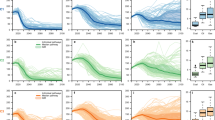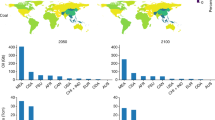Abstract
The Intergovernmental Panel on Climate Change (IPCC) commissioned a special report on emissions scenarios in 2000 so as to forecast global carbon dioxide (CO2) emissions for a variety of assumptions. These scenarios have been subjected to a multitude of criticisms, alleging overoptimistic predictions for fossil fuel production rates. Intrigued by this controversy, this paper employs the Hubbert linearization technique to solve for ultimately recoverable resources (URR) of fossil fuels for six significant IPCC scenarios. The predictions are substantially higher than geological URR estimates found in recent literature, ranging from 19 to over 200% higher for oil, 16 to over 500% for coal, and 171 to over 500% for natural gas, depending on the scenario. Subsequently, the atmospheric CO2 concentrations resulting from full consumption of URR related to IPCC data, as well as literature-based URR, are determined with a simple model. The former concentrations range from 640 to over 1,300 ppm. In comparison, the peak-based URR in the literature yield 463–577 ppm. All of these figures are higher than the 450 ppm ‘threshold’ which some see as critical. Therefore, despite peaking fossil fuels, concern over climate change is still warranted. At the same time, the fossil fuel production inputs to the IPCC’s CO2 emissions models appear predominantly overoptimistic, which calls into question the accuracy of the climate change assessment outputs. Moving forward, the IPCC is encouraged to re-assess its fossil fuel forecasts, incorporating more reasonable scenarios for peak production of fossil fuels.






















Similar content being viewed by others
Notes
Note that the economic conditions and the price of fossil fuels depend largely on the state of the global economy and the technology for fossil fuel extraction. This adds additional uncertainty to the SRES scenarios.
References
Bartlett, A. (2000). An analysis of U.S. and world oil production patterns using Hubbert-style curves. Mathematical Geology, 32(1), 1–17.
Bentley, R. W., Mannan, S. A., & Wheeler, S. J. (2007). Assessing the date of the global oil peak: The need to use 2P reserves. Energy Policy, 35, 6364–6382.
Berg, P., Hanz, P., & Milton, I. (2011). An energy-economic oil production model. IMA Journal of Applied Mathematics,. doi:10.1093/imamat/hxr049.
Berg, P., & Korte, S. (2008). Higher-order Hubbert models for the world oil production. Journal of Petroleum Science and Technology, 26, 217–230.
BGR. (2010). Reserves, resources and availability of energy resources 2010. Annual Report. Bundesanstalt fuer Geowissenschaften und Rohstoffe, Hannover.
BGR. (2011). Reserves, resources and availability of energy resources 2011. Annual Report. Bundesanstalt fuer Geowissenschaften und Rohstoffe, Hannover.
Brandt, A. R. (2007). Testing Hubbert. Energy Policy, 35, 3074–3088.
Brecha, R. J. (2008). Emission scenarios in the face of fossil fuel peaks. Energy Policy, 36(9), 3492–3504.
Campbell, C., & Laherrere, J. (1998, March). The end of cheap oil. Scientific American.
Cavallo, A. J. (2004). Hubbert’s petroleum production model: an evaluation and implications for world oil production forecasts. Natural Resources Research, 13(4), 211–221.
Coghlan, A. (2003). ‘Too little’ oil for global warming. New Scientists, 05 October 2003. http://www.newscientist.com/article/dn4216-too-little-oil-for-global-warming.html.
Hansen, J., et al. (2008). Target atmospheric CO2: Where should humanity aim? arXiv, arXiv:0804.1126.
Höök, M., Li, J., Oba, N., & Snowden, S. (2011). Descriptive and predictive growth curves in energy system analysis. Natural Resources Research, 20(2), 103–116.
Höök, M., Sivertsson, A., & Aleklett, K. (2010). Validity of the fossil fuel production outlooks in the IPCC emission scenarios. Natural Resources Research, 19(2), 63–81.
Höök, M., & Tang, X. (2013). Depletion of fossil fuels and anthropogenic climate change—A review. Energy Policy, 52, 797–809.
Hubbert, M. K. (1956). Nuclear energy and the fossil fuels. Drilling and Production Practice, American Petroleum Institute, New York, pp. 7–25.
Hubbert, M. K. (1959). Techniques of prediction with application to the petroleum industry. Shell Development Company, Exploration and Production Research Division, Houston, Publication 204.
Hubbert, M. K. (1982). Techniques of prediction as applied to the production of oil and gas (Vol. 631). Gaithersburg: National Bureau of Standards.
Hughes, D. (2011). Will natural gas fuel America in the 21st century?. Santa Rosa, CA: Post Carbon Institute.
IEA. (2011). IEA world energy outlook 2011. Paris: International Energy Agency.
IEA. (2012). IEA world energy outlook 2012. Paris: International Energy Agency.
IPCC. (2007). IPCC fourth assessment report. Climate change 2007: Synthesis report. Intergovernmental Panel on Climate Change, Geneva.
Jevons, W. S. (1865). The coal question: an inquiry concerning the progress of the nation. London: Macmillan.
Joos, F., Bruno, M., Fink, R., Siegenthaler, U., Stocker, T. F., Le Quere, C., et al. (1996). An efficient and accurate representation of complex oceanic and biospheric models of anthropogenic carbon uptake. Tellus, Series A and Series B, 48B, 397–417.
Kharech, P. A., & Hansen, J. E. (2008). Implications of peak oil for atmospheric CO2 and climate. Global Biogeochemical Cycles, 22, GB3012. doi:10.1029/2007GB003142.
Laherrere, J. (2001). Estimates of oil reserves. Resource document. Paper presented at EMF/IEA/IEW Meeting, IIASA, Laxenburg, 19 June 2001. http://www.energycrisis.com/laherrere/iiasa_reserves_long.pdf.
Meadows, D. H., Meadows, D. L., Randers, J., & Behrens, W. W, I. I. I. (1972). The limits to growth. New York: Universe Books.
Murphy, T. (2011). Is climate change real? Resource document. OilPrice. http://oilprice.com/The-Environment/Global-Warming/Is-Climate-Change-Real-Take-a-Look-at-the-Science-Before-you-Decide.html. Accessed 5 April 2013.
Nehring, R. (2006a). Two basins show Hubbert’s method underestimates future oil production. Oil & Gas Journal, 104(13), 37–42.
Nehring, R. (2006b). How Hubbert method fails to predict oil production in the Permian Basin. Oil & Gas Journal, 104(15), 30–35.
Nehring, R. (2006c). Post-Hubbert challenge is to find new methods to predict production. Oil & Gas Journal, 104(16), 43–46.
Patzek, T. W., & Croft, G. D. (2010). A global coal production forecast with multi-Hubbert cycle analysis. Energy, 35(8), 3109–3122.
Rogner, H.-H. (1997). An assessment of world hydrocarbon resources. Annual Review of Energy and Environment, 22, 217–262.
Rutledge, D. (2010). Estimating long-term world coal production with logit and probit transforms. International Journal of Coal Geology, 85(1), 23–33.
Sorrell, S., & Speirs, J. (2010). Hubbert’s legacy: A review of curve-fitting methods to estimate ultimately recoverable resources. Natural Resources Research, 19(3), 209–230.
SRES. (2000). Special report on emissions scenarios. ISBN: 92-9169-113-5. Intergovernmental Panel on Climate Change, The Hague.
Turner, G. M. (2008). A comparison of the limits to growth with 30 years of reality. Global Environmental Change, 18, 397–411.
UKERC. (2009a). Global oil depletion. ISBN 1-903144-0-35.
UKERC. (2009b). Technical report 2: Definition and interpretation of reserve estimates. UKERC/WP/TPA/2009/017.
UKERC. (2009c). Technical report 3: The nature and importance of reserve growth. UKERC/WP/TPA/2009/018.
UKERC. (2009d). Technical report 5: Methods of estimating ultimately recoverable resources. UKERC/WP/TPA/2009/020.
US EIA. (2011). International energy outlook 2011. Washington, DC: Energy Information Agency.
Author information
Authors and Affiliations
Corresponding author
Rights and permissions
About this article
Cite this article
Berg, P., Boland, A. Analysis of Ultimate Fossil Fuel Reserves and Associated CO2 Emissions in IPCC Scenarios. Nat Resour Res 23, 141–158 (2014). https://doi.org/10.1007/s11053-013-9207-7
Received:
Accepted:
Published:
Issue Date:
DOI: https://doi.org/10.1007/s11053-013-9207-7




